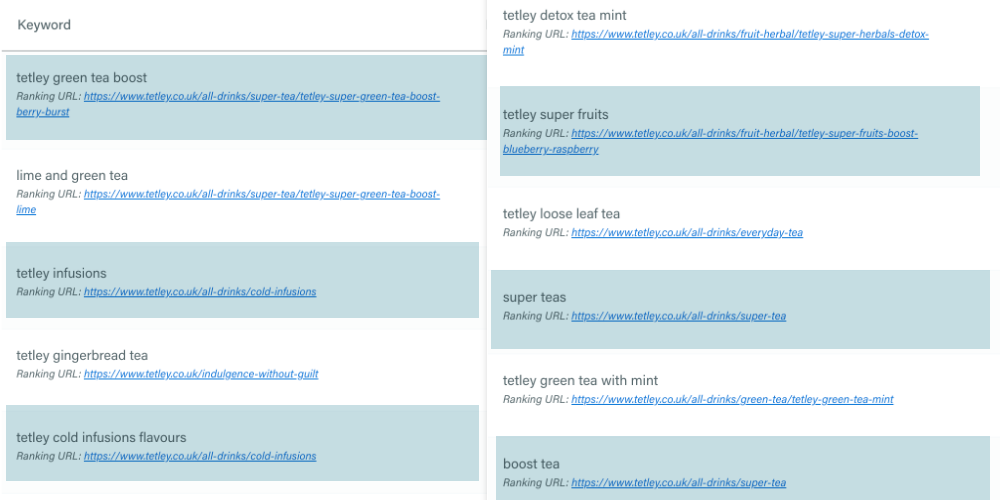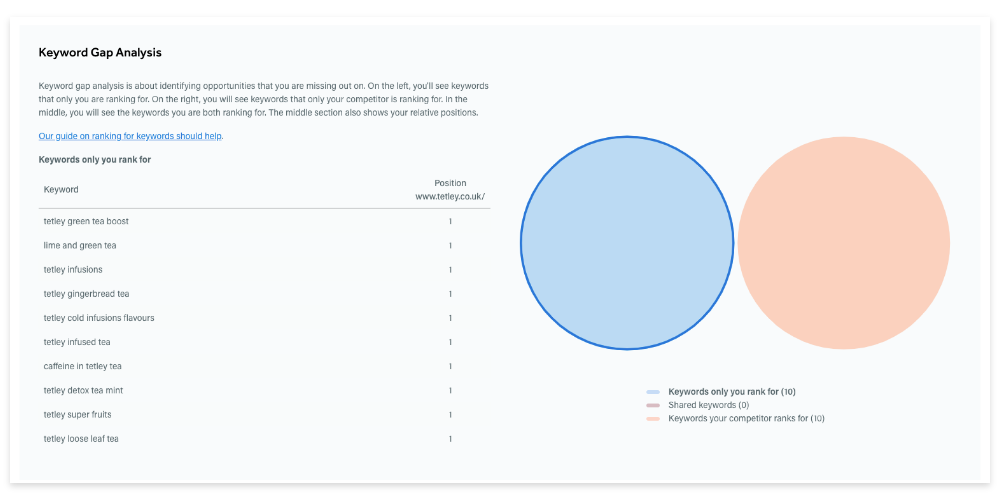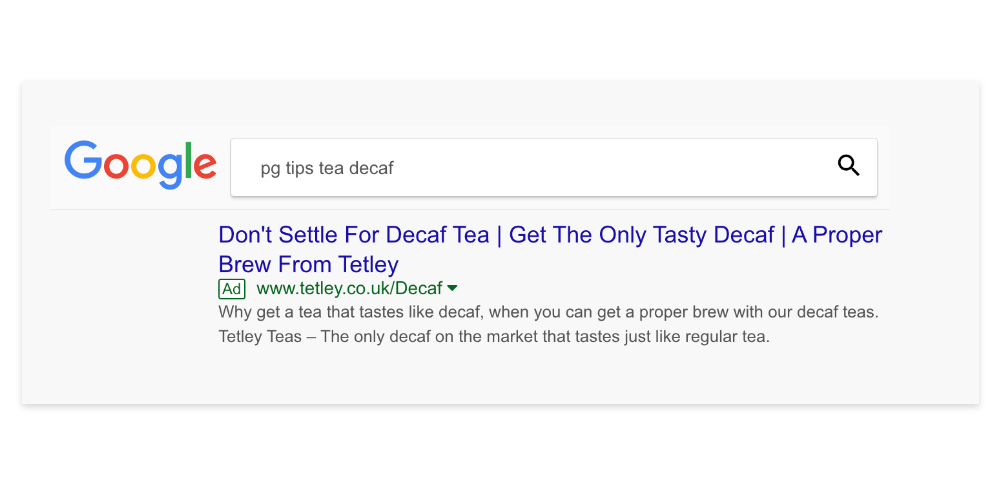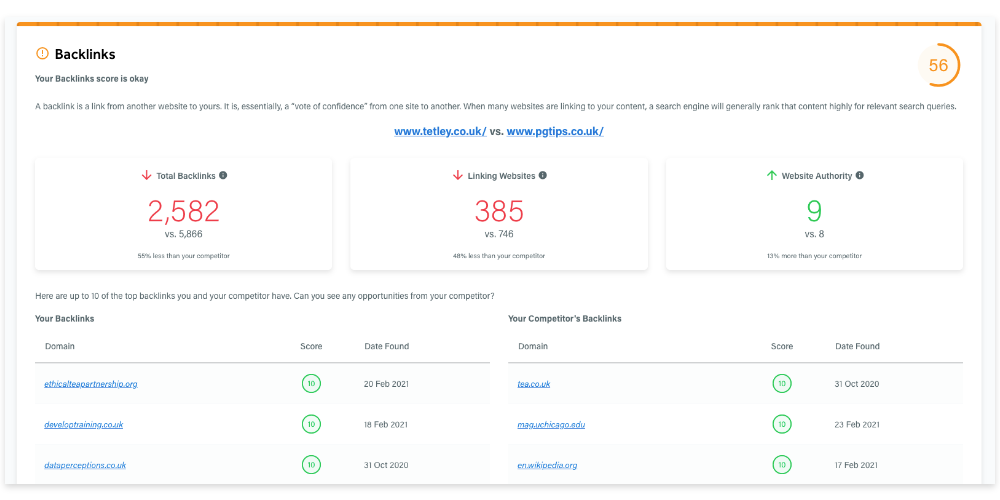An SEO strategy is a plan designed to improve your organic search rankings, increase your organic traffic and ultimately increase your conversions.
That’s all great. But if you have little to no SEO knowledge, it might sound like a pipe dream without investing in an in-house expert or an expensive agency to show you the way. And yeah, if you don’t have the time or inclination, you can turn to an agency or a consultant.
But, we’re here to tell you that building a powerful SEO strategy can be done alone, without the need of in-depth knowledge or expensive tools.
And to prove it, we’re going to help you create your own strategy, step-by-step, using our very own free SEO report.
Ready to get started?
First, let’s get your data
The first step to any strategy is to see where you’re at right now. You need to get a measure of what your current performance is, what your weak points are and where you have the most potential for growth.
Trying to start your strategy without this information is like starting to build a house without checking if you’re on solid ground.
Let us get a look at your data first then.
For this, you’re going to need to load up your SEO Performance Report. To access this, log into your Adzooma account, click reports at the top and select the SEO Performance report.
Then, you need to enter your URL, select your target country and click the ‘Run Report’ button.

You can also enter a competitors URL here as well to compare your performance against theirs, which is a useful tool we’ll cover later in the article.
While your SEO Report loads, you can watch this video explaining what results you’ll see in each of the sections.
1. Find content opportunity in your keywords
The first section you’ll see in your SEO report is your keyword performance. This section will show where your website ranks for selected keywords, as well as other phrases that you might not be aware of.
And there lies our opportunity to start building your SEO strategy on one of it’s most important cornerstones: content.
When we say content here, we don’t mean bland blogs with keywords stuffed into them. We mean interesting, insightful blogs, videos, pages, podcasts, etc that provide value and are interesting to your target audience.
Great content won’t just drive up your rankings, but also provide another avenue for customers to interact with your brand.
So, let’s have a look at your top performing keywords as a base.
Using Tetley Tea as an example, we can see from their SEO Performance Report that they’re already ranking for a lot of keywords about their infused flavours or ‘boost teas’.
Putting those together, we could create great content for Tetley for topics such as:
- How these teas can reduce tiredness
- What to eat and drink for your metabolism
- Health benefits of ‘super teas’
- And so on

If you’ve entered a competitor on your SEO Performance Report, you’ll also see the keywords your competitors are ranking for, as well as a keyword gap analysis.
This will show you:
- The keywords that you are ranking for, and your competitor’s aren’t.
- The keywords you both rank for and the relative positions.
- The keywords your competitors are ranking for, and you aren’t.

In our SEO Performance Report, we added PG Tips as a competitor. This brought out these keywords that PG tips were ranking for, and Tetley Tea weren’t:
- how much caffeine in pg tips tea
- how is pg tips tea decaffeinated
- pg tips newsletter
- pg tips tea decaf
- pg tips decaf tea bags
- are pg tips tea bags plastic-free
- what does pg stand for in pg tips
- pg tips complaint
- pg tips decaf tea
- pg tips cup
Although most of these keywords are branded, we can see a few topics here that PG Tips are ranking for that Tetley could use for themselves, including decaf tea.
As well as becoming a part of your SEO strategy, these keywords could also influence great competitor PPC campaigns. For example, if Tetley were to target the ‘pg tips tea decaf’ or ‘pg tips decaf tea’ keywords, they could run an advert like this to gain some of their competitor’s organic traffic.

2. Build your keyword list out
Now you have your general topics, it’s time to build your keyword list out.
There are a number of tools that you can use for this part, including SEMrush’s Keyword Magic Tool, Google Trends and Answer the Public. If you’ve not used a keyword tool before, you’ll want to see our guide to 18 of the best SEO keyword tools and tips.
When you’re picking keywords here, don’t just aim for the ones with the most traffic. Generally speaking, the more traffic they receive, the harder they’ll be to rank for. So you’ll need a good mix of low-volume keywords to target for your chosen topics.
Here’s one piece of advice to follow when building out this part of your SEO strategy:
Don’t think keywords, think search intent.
Search intent is a simple term to represent an incredibly important piece of information. Namely, when users search for something on the internet, they are doing it for a very particular reason.
In order to serve the best content, search engines like Google categorise search intent into four different categories:
- Informational. This is when users are after a particular piece of information. They are often questions that ask who, what, where, when or why.
- E.g. “Can teabags be put in a compost bin?”
- Navigational. This is when users are after a specific webpage or location, usually for brands or websites that they’re familiar with.
- E.g. “Tetley customer support”
- Commercial. This is where users are interested in and researching a product, and are looking for reviews, comparisons or information about which one they should buy.
- E.g. “Best green tea UK”
- Transactional. This is made by people who are ready to buy a product, and tend to be ultra targeted and specific searches.
- E.g. “Buy Tetley Green Tea Berry Burst”
With this in mind, you want to make sure that the keywords you’re targeting are fit for purpose. There’s no point building keywords into your strategy that don’t match up to user intent, as it doesn’t provide value to your customers and Google won’t show them.
3. Let’s get technical
Okay, here’s the part where most people get intimidated and drop out. But before you get spooked by technical SEO, let me reassure you that you don’t need to be a developer to build this into your SEO Strategy.
Technical SEO involves making sure technical aspects of your website and content are easy for users to access, and easy for search engines to index.
With your SEO Performance Report, you’ll already have the technical SEO actions you need to build into your SEO strategy. We’ve broken them down into two simple sections:
- Your onsite SEO, which gives you recommendations to optimise specific pages on your website.
- Your page speed, which gives you recommendations to speed up your website.
In the Onsite SEO section, you’ll get a list of actions that you need to take, why it’s important and what you need to do to implement this action.

Everything is explained for you inside your report. For example, Tetley Tea will see this as one of their Onsite SEO actions:
Your page https://www.tetley.co.uk/ doesn’t have a H1 heading, including this can help your SEO
When we click into it, we’ll find out that:
H1 headings help readers (and search engines) understand what your content is about. Using H1 tags to structure your page correlates with higher ranking, and therefore we recommend you use them. Normally, the H1 tag will give the reader a strong sense of what they are going to read. Above all else, it should be accurate!
We’ll also get information that H1 headings can also help you rank for a particular keyword and it’s recommended to include that keyword within the main H1 heading. In addition, you’ll also get an example so you can see how it’s done.
The page speed section of the SEO Performance Report also offers similar information, but for actions that affect your website speed.

They’ll also show the exact URLs, images and files that could be slowing down your website and losing you conversions, so you can go straight to fixing it.
Armed with this information, and what actions you need to take, you can quickly fill in the technical SEO details to your SEO strategy.
4. Create a solid backlink profile
Last but not least, we have backlinks.
Backlinks are a link from another website, to yours. Each link counts as a vote of confidence towards your website in the eyes of a search engine, which means that your website will start being seen as an authority figure. The more authoritative and trustworthy your website is, the better you’ll rank.
On your SEO Performance Report, the backlink section will show you:
- The total number of backlinks your website has
- The number of websites that link to your website
- Your website authority, which is a score out of 10 to measure the quality & quantity of backlinks to your website
- A list of some of your most recent backlinks and their individual quality scores.

If you entered a competitor URL, you’ll also see all of this information in comparison to your competitor, as well as a list of some of their most recent backlinks.
This section can be used to create a quality backlink profile in a number of ways.
Firstly, it gives you an overview of the authority of your website and the quality of your backlinks. If your score is low, then you need to focus on gaining backlinks from more authoritative websites.
In the backlink game, quality beats quantity here every time. 20 average backlinks could be less effective than one link from an amazing site. Think high, aim high here.
One way to check a website’s authority is by using Moz’s Domain Authority (DA) metric. Enter any URL in this tool, or install their toolbar to check DA scores on the go. Generally, websites that have a domain authority of 10 or under should be avoided and those with a score of 40 and above are your golden ticket.
Remember those topics we created earlier? Why not create some guest posts to feature on other websites. This is a great place to gain backlinks, build relationships with people in your industry and gain additional traffic to your website.
Secondly, you can use the recent backlinks list to take a look at which pieces of your content are already being shared – and any low scorers that you might want to avoid in the future. If you’ve got one really popular page, why not increase this success with more content that points to it?
This will also help you build link equity. This is a fancy SEO term that basically means certain links pass value and authority. So, if you’ve got a relevant and popular page, it’s going to have more ‘link power’ than others.
Lastly, take inspiration from your competitors. If they’re getting backlinks from websites you haven’t considered before, put them into your SEO strategy. Even better, think of similar websites that they haven’t got on their list and target them.
Plan, action & repeat
And there you have it, how to build an SEO strategy from one report.
Now the hard planning part is over, you just need to carry out the plan and then check in on your results. We can’t stress the importance of this part.
You need to make sure that what you’re doing is having an impact on your business. If there are parts of it that are working better than others, you need to know so you can improve your strategy and deliver even better results.
To keep an eye on your results, we’d recommend running your SEO Performance Report at least once a month. You’ll be able to compare your scores over time and get continuous new actions and recommendations to take your SEO efforts to the next level.




